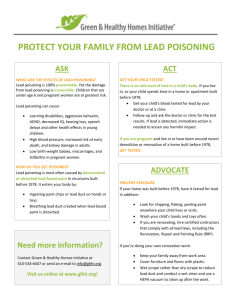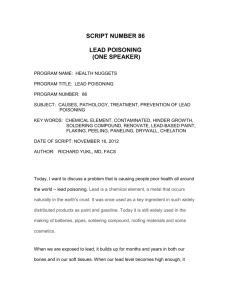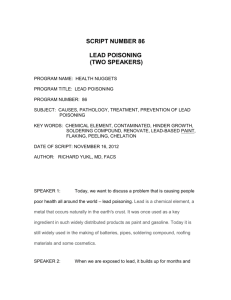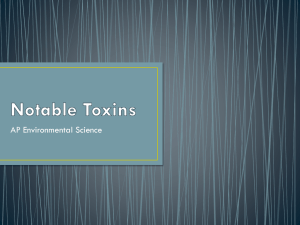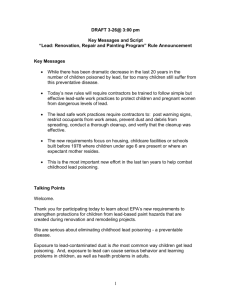Lead Out - Moore Public Schools
advertisement
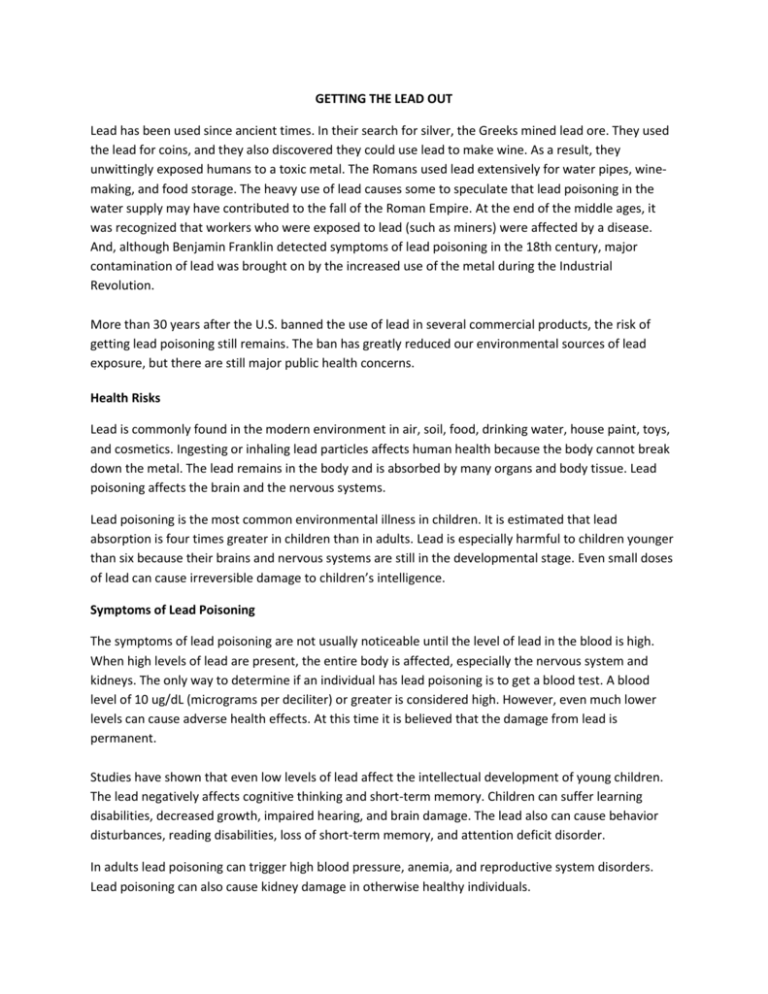
GETTING THE LEAD OUT Lead has been used since ancient times. In their search for silver, the Greeks mined lead ore. They used the lead for coins, and they also discovered they could use lead to make wine. As a result, they unwittingly exposed humans to a toxic metal. The Romans used lead extensively for water pipes, winemaking, and food storage. The heavy use of lead causes some to speculate that lead poisoning in the water supply may have contributed to the fall of the Roman Empire. At the end of the middle ages, it was recognized that workers who were exposed to lead (such as miners) were affected by a disease. And, although Benjamin Franklin detected symptoms of lead poisoning in the 18th century, major contamination of lead was brought on by the increased use of the metal during the Industrial Revolution. More than 30 years after the U.S. banned the use of lead in several commercial products, the risk of getting lead poisoning still remains. The ban has greatly reduced our environmental sources of lead exposure, but there are still major public health concerns. Health Risks Lead is commonly found in the modern environment in air, soil, food, drinking water, house paint, toys, and cosmetics. Ingesting or inhaling lead particles affects human health because the body cannot break down the metal. The lead remains in the body and is absorbed by many organs and body tissue. Lead poisoning affects the brain and the nervous systems. Lead poisoning is the most common environmental illness in children. It is estimated that lead absorption is four times greater in children than in adults. Lead is especially harmful to children younger than six because their brains and nervous systems are still in the developmental stage. Even small doses of lead can cause irreversible damage to children’s intelligence. Symptoms of Lead Poisoning The symptoms of lead poisoning are not usually noticeable until the level of lead in the blood is high. When high levels of lead are present, the entire body is affected, especially the nervous system and kidneys. The only way to determine if an individual has lead poisoning is to get a blood test. A blood level of 10 ug/dL (micrograms per deciliter) or greater is considered high. However, even much lower levels can cause adverse health effects. At this time it is believed that the damage from lead is permanent. Studies have shown that even low levels of lead affect the intellectual development of young children. The lead negatively affects cognitive thinking and short-term memory. Children can suffer learning disabilities, decreased growth, impaired hearing, and brain damage. The lead also can cause behavior disturbances, reading disabilities, loss of short-term memory, and attention deficit disorder. In adults lead poisoning can trigger high blood pressure, anemia, and reproductive system disorders. Lead poisoning can also cause kidney damage in otherwise healthy individuals. Exposures to Lead Lead is commonly used in older metal toys, ceramics, bullets, batteries, and fishing and diving weights, and is found to contaminate soil. Prior to 1978, lead was an additive to gasoline and paint. Dietary sources of lead include contamination of agricultural crops, lead in food containers, contaminated drinking water, and unexpected sources such as lead shot in game birds. Here’s a closer look at how humans are exposed to lead. Lead in drinking water. The lead in drinking water most likely results from lead that leaches in from pipes due to corrosion. Through the 1920s, lead was used in household pipes. Newer homes now have copper pipes. However, up until 1988, lead solder was legally still being used for plumbing. Many cities over 100 years old still have lead in the pipes that run between the main water supply and individual homes. In addition, faucets often have brass/lead valves. Even faucets labeled as “lead free” are permitted to contain up to 8 percent lead. The worst case situation for exposure to lead is water that is left standing in pipes for one to three days. Lead glazes in pottery, crystal, and kitchenware. In 1978, the U.S. ban on lead included dishes and cookware. However, recent investigations show that lead can still be found in glazed ceramics. Brightly colored ceramic tableware and pottery can leak lead and contaminate food. Acidic foods such as apple juice or spaghetti sauce cause the lead to leak more. Paint. In 1978, the U.S. banned lead-based paints for residential use, furniture, and toys. Collectibles and antique toys passed down through generations may also be a health hazard. The lead can be found in the paint and/or in the plastics. Also toys made in other countries and imported to the U.S. may also contain lead because the other countries do not have standards for lead in the products. Plastics. Lead is used to soften plastic and make it more flexible. When the plastic is exposed to sunlight, air, and detergents, the bond between the plastics and the lead breaks down and a dust appears. Lead is not banned in plastics, and children may be exposed to lead in plastic toys either by breathing the dust or putting the toy in their mouth. Work. Occupational exposure to lead puts workers and families at risk. Many occupations, including home improvement, plumbing, construction, car or radiator repair, welding and cutting, electronics, rubber, plastics, battery manufacturing, and more subject workers to the risk of being exposed to lead. While on the job, workers may get lead dust on their clothing, shoes, or hair and then when they go home from work they expose family members to the lead dust. Soil. Before lead in gas was banned in 1978, lead particles escaped from the exhaust systems in cars. Once in the air, the lead particles settled to the ground near the roadways and were mixed in with the soil. Although leaded gasoline has been banned for more than thirty years, the lead is still in the soil. Lead also mixes in with the soil when lead-based paint peels off and falls from the outside of buildings. Jewelry and cosmetics. Inexpensive jewelry often contains lead. Some cosmetics, including eye liners and lipsticks also are lead-based. Candy and foods. Certain ethnic spices, foods, and folk medicines include lead. Lead is also found in the food wrappers and in pottery containers. Prevention of Lead Poisoning Test your home for lead-based paint. Your local health department may provide a service, or hometest kits are available. Don’t strip old paint yourself; hire professionals to do it. Test the water in your home. Consider contacting a water testing lab in your area; some labs will test for free. Home-test kits are available, too. Flush the line before drinking or cooking with the water. Flush until the water runs cold, maybe as little as 30 seconds or as much as two minutes. Do not boil water needlessly. Boiling concentrates the lead in the water. Replace lead pipes with PVC plastic or copper. Copper corrosion also presents a health problem. Use a home water filter. Use lead-free, non-toxic dinnerware. To ensure that the pottery glaze is lead-free, read the labels or contact the manufacturer. If your occupation exposes you to lead dust, use separate clothing, shoes, and boots, and change before you come home and wash your clothes. Be cautious about hobbies such as making pottery and working with stained glass or scrap metals.

